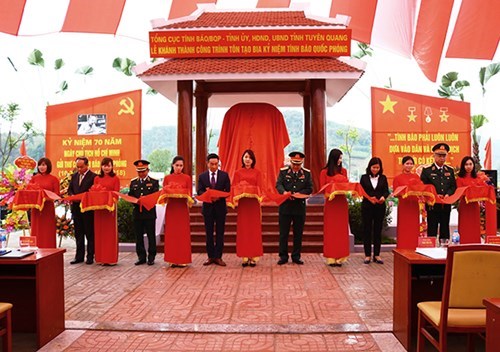March 09, 2018 | 21:08 (GMT+7)
Monument dedicated to defense intelligence sector upgraded
PANO - The General Department of Defense Intelligence (GDDI) under the Ministry of National Defense on March 8 inaugurated the upgraded monument dedicated to the defense intelligence sector in Thuong Am commune, Son Duong district, Tuyen Quang province.
Lieutenant General Phan Van Viet, Secretary of the Party Committee and Political Commissar of the GDDI chaired the ceremony.
After the victory of the Border Campaign in 1950, the Central Committee of the Communist Party of Vietnam issued Directive No.07 in order to enhance intelligence service to realize the Party’s strategic directions in new situations.
    |
 |
|
Delegates cutting the ribbon to unveil the upgraded monument |
On May 17, 1951, the Government of Vietnam issued Decree No.42 on establishing the Strategic Intelligence Department, which used the alias Liaison Office under the Prime Minister’s Office. The founding of such an office marked an important turning-point of the intelligence sector.
Right after the establishment, the Liaison Office set up its headquarters in Thuong Am commune.
In 2000, on the occasion of the 55th founding anniversary of the defense intelligence sector, the GDDI and Am Thuong commune’s authorities joined hands to build a monument at the stationed place of the Strategic Intelligence Department as a token of gratitude towards President Ho Chi Minh. The monument also aims to mark important historic landmarks of the Strategic Intelligence Department and recognize great contributions of generations of cadres and soldiers of the defense intelligence sector as well as thank local people for their great support.
Since then, this place has become a “red address” to help educate the tradition and foster the revolutionary ideal among young officers of the sector and local people.
The completion of the upgraded monument on the occasion of the 70 years of the Day when President Ho Chi Minh sent a letter to the defense intelligence sector (March 10, 1948-2018) was of significance, showing the Vietnamese tradition of “When drinking water, remember its source.”
Also at the ceremony, GDDI presented 64 gifts to local policy families, a TV set and 400 face towels to Am Thuong Commune Kindergarten, a saving book to Mrs. Hua Thi Phuong, a martyr’s mother facing adversity in life in Ham Ech village.
Translated by Mai Huong